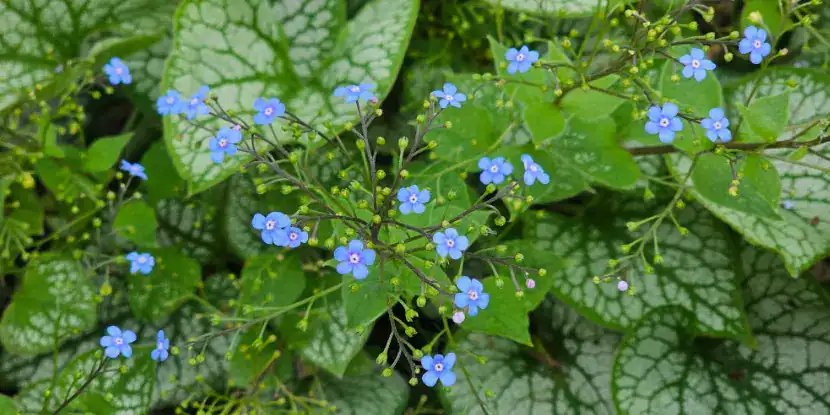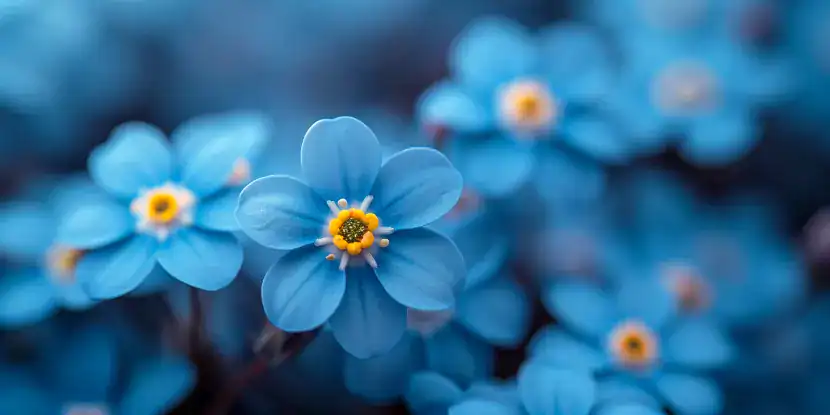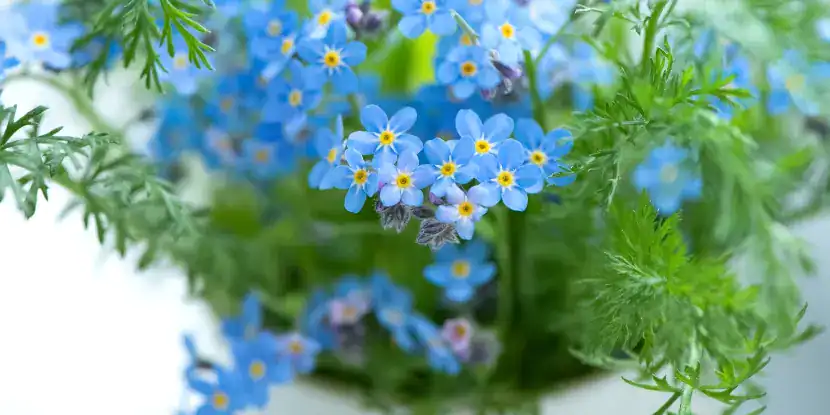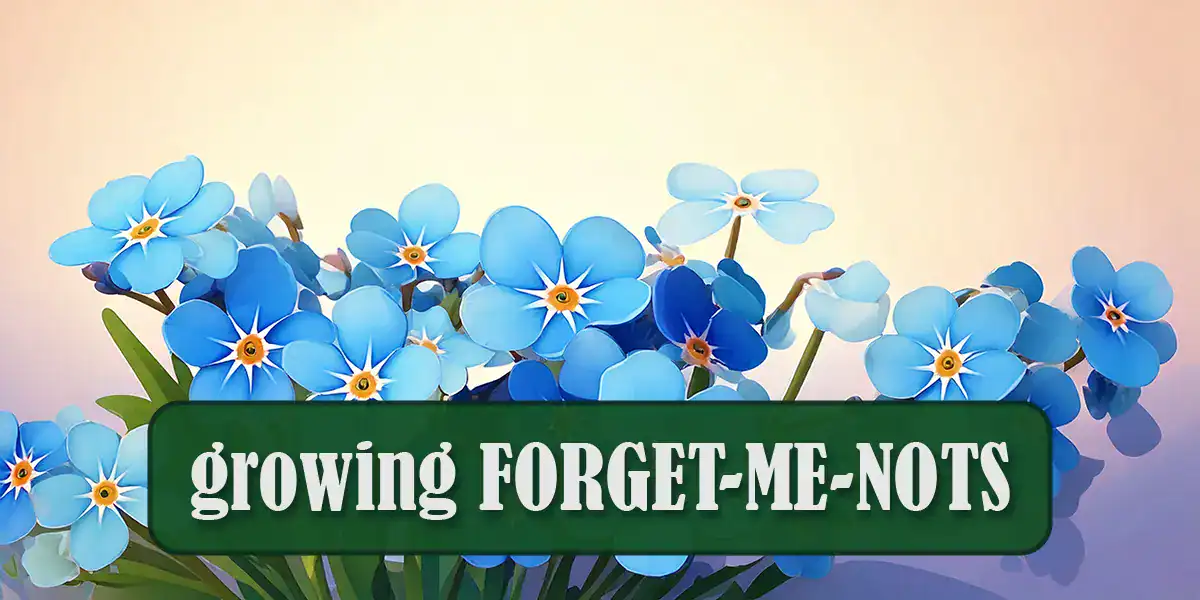Forget-me-nots thrive in cool, misty climates — not exactly the picture of Los Angeles in August. But it’s possible to cultivate these charming blossoms in a warm environment, even inland in SoCal.
The trick lies in choosing the right varieties and creating microclimates that mimic their preferred conditions. The payoff is well worth it — imagine clusters of tiny blue, pink, or white flowers carpeting shaded corners of your garden each spring.
Understanding Forget-Me-Nots
The name “forget-me-not” comes from medieval legend. A knight was picking the flowers for his beloved when he tumbled into a river. The drowning man tossed the bouquet to shore and called, “Forget me not!” — giving the flower its enduring name and association with remembrance.
Love conquers all — except a swift river current when you’ve strapped on 50 lbs of armor.
Scientifically, these plants belong to the genus Myosotis, which means “mouse’s ear” in Greek. The name refers to their soft, fuzzy leaves. Over 70 species exist worldwide, naturally occurring across temperate regions of Europe, Asia, and North America.

Way to go, lover boy! Don’t fall into the river!
Key Characteristics
- Small, five-petaled flowers (typically blue with yellow centers)
- Soft, hairy leaves
- Height ranging from 6 to 12 inches, depending on variety
- Self-seeding habit that creates natural colonies
- Early spring blooming
In their native habitats, forget-me-nots carpet forest floors and alpine meadows. They’ve adapted to cool temperatures, consistent moisture, and filtered sunlight.
Best Varieties for a Warm Climate
Myosotis sylvatica ‘Victoria Rose’
- Compact growth (6-8 inches tall)
- Rose-pink flowers instead of traditional blue
- Better heat tolerance than standard varieties
- Excellent for containers and small spaces
Myosotis alpestris (Alpine Forget-Me-Not)
- Classic sky-blue blooms
- Naturally adapted to temperature fluctuations
- Shorter-lived but reliable self-seeding
- Best in cooler microclimates within your garden
Myosotis scorpioides (Water Forget-Me-Not)
- Loves consistently moist conditions
- Longer blooming period than other varieties
- Perfect for pond edges or bog gardens
- More tolerant of humidity and warmth

Myosotis sylvatica, the wood forget-me-not.
Creating the Right Growing Conditions
Light Requirements
- Morning sun (2-4 hours maximum)
- Afternoon shade or dappled light
- Protection from harsh western exposure
- Filtered light under trees or large shrubs
Ideal locations include:
- East-facing garden beds
- Areas beneath deciduous trees
- North sides of buildings or fences
- Spots protected by taller plants
Temperature Management
Forget-me-nots prefer temperatures between 50-70°F. In Southern California, this means:
- Plant in the fall for spring blooms
- Expect a decline during the summer heat
- Focus on cool-season performance
- Use mulch to moderate soil temperature

Close-up showing the blue petals and yellow centers of the forget-me-not flower.
Soil & Moisture Needs
Create woodland-like conditions with:
- Rich, organic soil amended with compost
- Consistent moisture without waterlogging
- Good drainage to prevent root rot
- 2–3 inches of mulch to retain moisture and cool roots
Soil Preparation
- Dig a planting area 6–8 inches deep
- Mix in 2–3 inches of compost or leaf mold
- Ensure drainage by adding perlite
- Test soil pH (prefer slightly acidic to neutral, 6.0 to 7.0)
Planting & Propagation
Starting from Seed
Growing from seed is the most economical approach and allows for a broader selection of heat-adapted plants.
Direct Seeding
- Sow seeds in fall (October-November)
- Scatter on a prepared soil surface
- Lightly rake to barely cover seeds
- Keep soil consistently moist
- Expect germination in 1–2 weeks

A cluster of delicate forget-me-not flowers.
Starting Indoors
- Start seeds 8–10 weeks before the last frost
- Use seed-starting mix in small containers
- Press seeds lightly into the surface (need light to germinate)
- Maintain 60-65°F temperature
- Transplant when seedlings reach 2–3 inches
Transplanting Seedlings
- Space plants 6–8 inches apart
- Plant at the same depth as in containers
- Water thoroughly after transplanting
- Provide shade cloth if temperatures exceed 75°F
- Mulch around plants immediately
Ongoing Care & Maintenance
Watering
Consistent moisture is critical, especially during the blooming season.
- Water deeply but less frequently
- Check soil moisture daily during hot weather
- Use drip irrigation or soaker hoses to minimize evaporation
- Water early in the morning to reduce fungal issues
- Reduce watering as plants decline in summer
Fertilizing
Light feeding produces better results than heavy fertilization.
- Apply a balanced fertilizer (10-10-10) in early spring
- Use compost as an ongoing soil amendment
- Avoid high-nitrogen fertilizers that promote excessive foliage
- Side-dress with compost mid-season if needed

Light blue forget-me-not blossoms against a backdrop of weathered wood.
Managing Self-Seeding
Forget-me-nots readily self-seed, which can be a blessing and a challenge.
To encourage self-seeding:
- Allow some flowers to go to seed
- Avoid heavy mulching in seeding areas
- Lightly rake the soil in the fall to create germination sites
- Mark seeded areas to avoid accidental weeding
To control spreading:
- Deadhead flowers before seed formation
- Remove entire plants after blooming
- Use edging to contain colonies
- Hand-pull unwanted seedlings
Seasonal Management
Fall (October-December)
- Plant new seeds or transplants
- Prepare planting beds with compost
- Begin a regular watering schedule
Winter (January-March)
- Monitor for slug damage
- Maintain consistent soil moisture
- Watch for the first flower buds
Spring (April-May)
- Enjoy the peak blooming period
- Deadhead for extended flowering
- Collect seeds if desired
Summer (June-September)
- Allow plants to decline naturally
- Reduce watering as foliage dies back
- Prepare beds for fall planting

Growing forget-me-nots in containers allows you to move them to protected areas.
FAQs: Growing Forget-Me-Nots
Q: Will forget-me-nots survive Southern California summers?
Most varieties decline in summer heat, but they often return through self-seeding. Treat them as cool-season annuals for best results.
Q: Can I grow forget-me-nots in containers?
Yes, containers work well because you can move them to cooler locations during hot weather. Use large pots with good drainage and quality potting mix.
Q: How long do forget-me-nots bloom?
Expect 4–6 weeks of blooming in spring. Deadheading spent flowers can extend the display slightly.
Q: Are forget-me-nots invasive in warm climates?
They’re much less aggressive in hot, dry conditions than in cool, moist climates. Self-seeding is usually manageable with basic garden maintenance.
Q: What pests and diseases affect forget-me-nots?
Watch for aphids, slugs, and powdery mildew. Good air circulation and avoiding overhead watering help prevent most problems.
Q: Can I start plants from cuttings?
Forget-me-nots don’t root well from cuttings. Seed propagation is much more reliable and successful.
Q: Do forget-me-nots attract beneficial insects?
Their early spring blooms provide nectar for bees, butterflies, and other pollinators when few other flowers are available.
Q: What’s the best planting time in Southern California?
Fall planting (October-November) allows plants to establish during cool weather and bloom the following spring.

